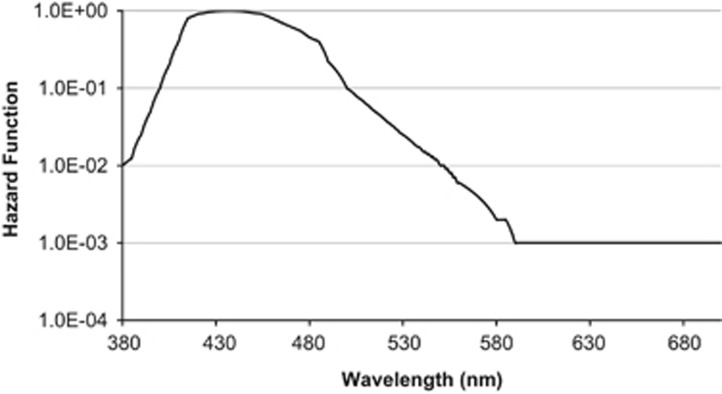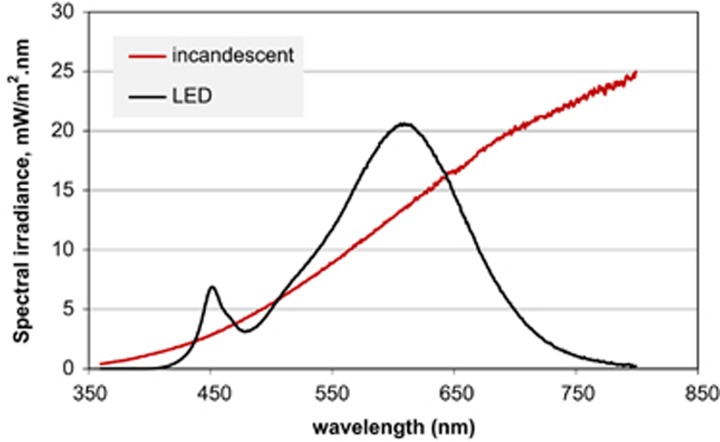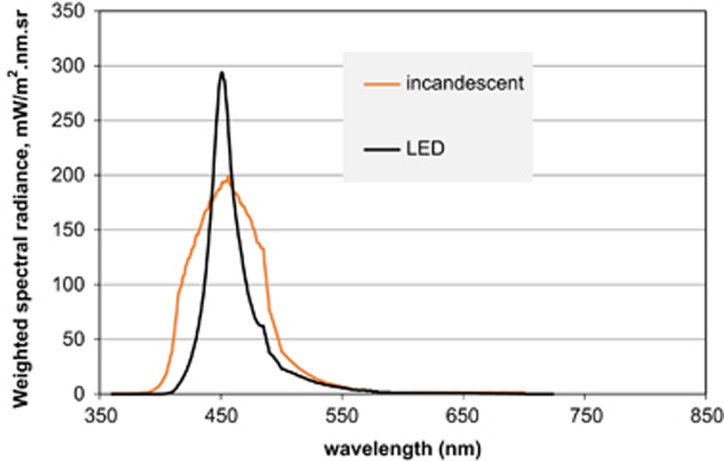Abstract
The introduction of low energy lighting and the widespread use of computer and mobile technologies have changed the exposure of human eyes to light. Occasional claims that the light sources with emissions containing blue light may cause eye damage raise concerns in the media. The aim of the study was to determine if it was appropriate to issue advice on the public health concerns. A number of sources were assessed and the exposure conditions were compared with international exposure limits, and the exposure likely to be received from staring at a blue sky. None of the sources assessed approached the exposure limits, even for extended viewing times.
Introduction
Humans evolved under light from the sun. For ~100 years reliable artificial light was available from incandescent lamps: a source of light that was similar in spectrum to that received from the sun. The pressure to use less energy has resulted in the phase-out of incandescent lighting, which is being replaced by so-called low energy devices, such as compact fluorescent lamps (CFLs) and light emitting diodes (LEDs). In parallel, incandescent indicator lamps in electrical and electronic products have been replaced with LEDs.
During the evolution of the lighting industry, many lessons have been learned in terms of the positioning of lamps in relation to the eye. For example, if a high luminance source is in the field of view, even if the exposure condition is not harmful, the exposure may result in glare, dazzle, and compromise the ability to carry out visual tasks. Therefore, traditional sources tend to be shielded from direct viewing when the direction of gaze is horizontal or below. Staring directly up into a light source would be considered unusual behaviour. However, studies have been published1 that imply risks of adverse health effects under extreme exposure conditions, which are then highlighted by the media.
The development of handheld computer-based technology has provided the opportunity for long-term viewing of illuminated screens. From a practical perspective, the luminance of the sources has to be low to be comfortable to view. However, it is recognised that many people are using laptop or tablet computers, or mobile phone technology, for many hours per day.
Blue light has been known to be phototoxic for the retina for many years.2 The biological evidence is reviewed periodically by organisations, such as the International Commission on Non-ionising Radiation Protection (ICNIRP), resulting in the publication of guidelines.3 The guidelines represent levels below which adverse health effects are unlikely. In terms of retinal exposure to light, some wavelengths are more effective at causing harm than others. This is recognised by an action spectrum for the blue light hazard, which is shown graphically in Figure 1. To assess an exposure condition, the spectrum of light at a specific location is measured and the value at each wavelength is weighted by the relevant factor at that wavelength. Finally, the weighted values are summed to give a weighted radiance or irradiance for comparison with the guideline exposure limit.
Figure 1.
Blue light hazard action spectrum.
ICNIRP has proposed a ‘rule of thumb' luminance trigger level for white light sources, suggesting that detailed assessments are not required for luminance values below 104 cd m−2.4 This rule takes account of the proportion of blue light likely to be contained in the total luminance of the source.
The ICNIRP guidelines from 19974 were incorporated into the Artificial Optical Radiation Directive,5 which limits the level of optical radiation exposure to workers.
This study does not address the implications of exposure to light for effects other than retinal damage.
Materials and methods
To provide a comparison with natural exposures to blue light, the spectral irradiance incident on the earth in southern UK (Chilton, 51.5750° N, 1.3177° W) was assessed from a clear blue sky in summer and for a cloudy day in winter. The radiance was determined using a charged coupled device (CCD) array spectrometer (QE65000, Ocean Optics, Inc., Dunedin, FL, USA), fibre coupled to a diffuser (Bentham Instruments, Reading, UK). A collimating tube mounting on top of the diffuser, 10 mm diameter and 200 mm long, limited the field of view.
A range of lamps (CFL and LED), computer screens, tablet computers, laptops, and smartphones were assessed for comparison with the blue light hazard exposure limit. In addition, an HDMI computer display switch with blue LED indicator lamps was assessed owing to concern from an ophthalmologist. Measurements were made using an Exemplar Plus CCD array spectroradiometer (B&W Tek Inc., Newark, DE, USA), S/N 655, coupled by a metal jacketed QP600-2-SR/BX optical fibre (Ocean Optics, Inc., Dunedin, FL, USA) to a D7-H diffuser, S/N 10083 (Bentham Instruments, Reading, UK). The system was calibrated using 1000 W tungsten–halogen lamps, calibrated for spectral irradiance to the Physikalisch-Technische Bundesanstalt traceable reference standards, S/N 548.
To assess worst case exposure conditions for someone staring at a screen for extended periods of time, images of various colours were generated using the Microsoft RGB colour gamut. The spectral irradiance incident on a person viewing the screen with the different colours was assessed.
Measurements were carried out with an open field of view to maximise the amount of light collected. If the exposure limit was not exceeded under these conditions then it would not be exceeded with a restricted field of view.
Results
The spectral irradiance from an incandescent lamp and a retrofit LED lamp are shown in Figure 2. Applying the blue light hazard weighting (Figure 1) emphasises the blue part of the spectrum, as shown in Figure 3. The blue light weighted radiance is summed and then compared with the radiance limit. A similar process was carried out for each source described below.
Figure 2.
Spectral irradiance from an incandescent lamp and an LED lamp.
Figure 3.
Blue light weighted spectral radiance from the lamps in Figure 2.
The blue sky spectral radiance, assessed for a typical clear day in June and a cloudy day in December was weighted with the blue light hazard weighting function to determine the blue light hazard. The weighted radiance was 10.4 W m−2 sr−1 and 3.4 W m−2 sr−1 in June and December, respectively. The ICNIRP exposure limit2 for long-term viewing (that is, staring at the sky) is 100 W m−2 sr−1. Therefore, it can be seen that these exposures represent 10.4% and 3.4% of the exposure limit. The luminance of the sky was also determined and the ratio of blue light hazard to luminance calculated. For the summer and winter exposures, the hazard ratio was 1.09 × 10−3 and 1.46 × 10−3 W lm−1, respectively (W m−2 sr−1/cd m−2=W lm−2, where 1 cd=1 lm sr−1). This parameter is useful for assessing similar sources that may vary in luminance, but have identical emission spectra: it permits an assessment of the blue light hazard by measuring the luminance.
The blue light hazard from an incandescent lamp was compared with two LED and one CFL retrofit domestic lamps and with a 600 mm square panel intended for office lighting. Apart from the panel lamp, all sources exceeded the ICNIRP rule of thumb luminance value of 104 cd m-2 by factors of between four and eight times. As the panel was an extended source, the luminance was lower and was 35% of 104 cd m−2. In terms of blue light hazard the domestic lamps ranged from 10 to 20% of the exposure limit, assuming intentional long-term viewing (>10000 s per day). It was notable that the incandescent lamp was towards the middle of the range (14%). The panel lamp was 1.7% of the blue light exposure limit. The blue light to luminance hazard ratios were similar for the domestic lamps, ranging from 2.3 × 10−4 to 2.9 × 10−4 W lm-1. The panel lamp had a ratio of 5.0 × 10−4 W lm−1.
Screens were divided into computer monitors, laptop screens, tablet computers, and smartphones. All devices were set to maximum brightness. After the first batch of measurements, it was clear that the highest luminance and blue light spectral irradiance occurred from a white screen. Any other colours were generated by removing part of the emission from the device. Therefore, only the worst case, white screen results are presented in Table 1.
Table 1. Luminance and blue light hazard from computer screens, laptops, tablet computers, and smartphones.
| ID | Luminance, cd m−2 | % of ICNIRP 104 cd m−2 rule of thumb (%) | Blue light weighted radiance, W m−2 sr−1 | % of ICNIRP blue light exposure limit (%) | Hazard ratio, W lm−1 |
|---|---|---|---|---|---|
| Computer monitors | |||||
| 1 | 126 | 1.26 | 0.110 | 0.11 | 8.73 × 10−4 |
| 24 | 71 | 0.71 | 0.054 | 0.05 | 7.61 × 10−4 |
| Laptop screens | |||||
| 9 | 152 | 1.52 | 0.130 | 0.13 | 8.55 × 10−4 |
| 10 | 63 | 0.63 | 0.048 | 0.05 | 7.61 × 10−4 |
| 11 | 101 | 1.01 | 0.084 | 0.08 | 8.32 × 10−4 |
| 12 | 88 | 0.88 | 0.072 | 0.07 | 8.18 × 10−4 |
| 14 | 148 | 1.48 | 0.120 | 0.12 | 8.11 × 10−4 |
| 15 | 137 | 1.37 | 0.110 | 0.11 | 8.03 × 10−4 |
| 20 | 104 | 1.04 | 0.082 | 0.08 | 7.88 × 10−4 |
| 22 | 184 | 1.84 | 0.150 | 0.15 | 8.15 × 10−4 |
| 23 | 197 | 1.97 | 0.170 | 0.17 | 8.63 × 10−4 |
| Tablet computer screens | |||||
| 3 | 175 | 1.75 | 0.150 | 0.15 | 8.57 × 10−4 |
| 4 | 94 | 0.94 | 0.084 | 0.08 | 8.94 × 10−4 |
| 5 | 63 | 0.63 | 0.053 | 0.05 | 8.41 × 10−4 |
| 6 | 43 | 0.43 | 0.034 | 0.03 | 7.91 × 10−4 |
| 7 | 142 | 1.42 | 0.131 | 0.13 | 9.23 × 10−4 |
| 17 | 238 | 2.38 | 0.214 | 0.21 | 8.99 × 10−4 |
| 18 | 140 | 1.40 | 0.120 | 0.12 | 8.57 × 10−4 |
| 19 | 191 | 1.91 | 0.176 | 0.18 | 9.21 × 10−4 |
| 26 | 203 | 2.03 | 0.180 | 0.18 | 8.87 × 10−4 |
| Smartphone screens | |||||
| 2 | 294 | 2.94 | 0.280 | 0.28 | 9.52 × 10−4 |
| 8 | 178 | 1.78 | 0.150 | 0.15 | 8.43 × 10−4 |
| 13 | 367 | 3.67 | 0.310 | 0.31 | 8.45 × 10−4 |
| 16 | 409 | 4.09 | 0.380 | 0.38 | 9.29 × 10−4 |
| 25 | 215 | 2.15 | 0.190 | 0.19 | 8.84 × 10−4 |
Following concerns from an ophthalmologist, an HDMI computer display switch with three blue LED indicators was assessed at a worst case viewing distance of 100 mm. As the LEDs were not white light sources, the rule of thumb of 104 cd m−2 was not appropriate. However, the luminance of the LEDs was over twice this value. The blue light weighted radiance limit for long-term viewing was exceeded by a factor of up to three. Therefore, it was necessary to determine the maximum intended exposure duration before the integrated radiance limit (106 J m−2 sr−1)3 for exposure durations between 0.25 and 10 000 s was exceeded. This maximum exposure duration was ~60 min for each LED.
Discussion
Humans have evolved under natural light from the sun. Intentional staring at the sun causes eye injuries, as is reported after solar eclipses.6, 7 However, continuous viewing of the blue sky, certainly in the UK, does not present a risk of eye injuries. Comparing natural exposures with the reasonably foreseeable exposure to optical radiation from lamps, computer screens and mobile devices, such as smartphones shows that the actual spectrally weighted irradiance is lower than the natural exposures.
For sources with similar emission spectra, it is possible to measure the luminance and predict the blue light hazard, as the ratio of blue light weighted irradiance to luminance is approximately constant for a given type of source.
In conclusion, under even extreme long-term viewing conditions, none of the assessed sources suggested cause for concern for public health. The worst assessed source consisted of three indicator LEDs, which were unlikely to be viewed close up for long enough to cause concern. However, these sources were representative of indicator lamps that did not require the assessed luminance for their intended function. The percentage transmission of blue light from the corneal surface to the retina is age related, with the transmission for children higher than for adults.8 Therefore, where such sources are uncomfortable to view for adults, they could be distressing for children.
The impact of the blue light from the studied sources on circadian rhythm and sleep quality was outside of the scope of this study.
The authors declare no conflict of interest.
References
- 1Chamorro E, Carralero SF, Bonnin-Arias C, Pérez-Carrasco MJ, de Luna JM et al. Photoprotective effects of blue light absorbing filter against LED light exposure on human retinal pigment epithelial cells in vitro. J Carcinog Mutagen 2013. S6: 008 doi:10.4172/2157-2518.
- 2Ham WT, Mueller HA. Retinal sensitivity to damage from short wavelength light. Nature 1976; 260: 153–155. [DOI] [PubMed] [Google Scholar]
- 3International Commission on Non-ionizing Radiation Protection. Guidelines on limits of exposure to incoherent visible and infrared radiation. Health Phys 2013; 105: 74–96. [DOI] [PubMed] [Google Scholar]
- 4International Commission on Non-ionizing Radiation Protection. Guidelines on limits of exposure to incoherent optical radiation (0.38–3 μm). Health Phys 1997; 73: 539–554. [PubMed] [Google Scholar]
- 5European Union. Directive 2006/25/EC of the European Parliament and of the Council of 5 April 2006 on the minimum health and safety requirements regarding the exposure of workers to risks arising from physical agents (artificial optical radiation) (19th individual Directive within the meaning of Article 16(1) of Directive 89/391/EEC). Official Journal of the European Union 2006; L 114: 38–59. [Google Scholar]
- 6Michaelides M, Rajendram R, Marshall J, Keightley S. Eclipse retinopathy. Eye 2001; 15: 148–151. [DOI] [PubMed] [Google Scholar]
- 7Doyle E, Sahu D, Ong G. Solar retinopathy after the 1999 solar eclipse in East Sussex. Eye 2002; 16: 203–206. [DOI] [PubMed] [Google Scholar]
- 8International Commission on Illumination (CIE). A Computerized Approach to Transmission and Absorption Characteristics of the Human Eye, CIE 203:2012 incl. Erratum 1: Vienna, Austria, 2012.





